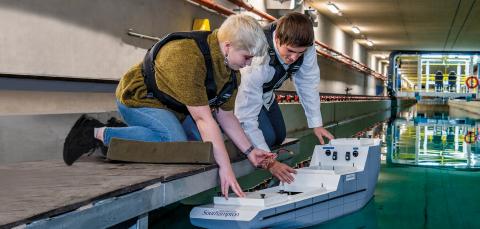Naval Architecture is a very specialized field that calls for a particular set of abilities and information. Knowing the Best Naval Architecture Schools that provide high-quality education in naval engineering is crucial given the rising demand for qualified individuals in this industry.
The engineering discipline of naval architecture, also known as naval engineering, integrates elements of mechanical, electrical, electronic, software, and safety engineering to design, construct, maintain, and operate maritime structures.
The best institutions that offer top-notch instruction and training in this discipline are located in the United States, which is home to some of the best naval Architecture/engineering schools in the United States.
Table of contents
- What is Naval Architecture?
- What does a Naval Architect do?
- How long does it take to get a degree in Naval Architecture?
- What are the Best Naval Architecture Schools?
- 1. US Naval Academy (Annapolis, MD)
- 2. SUNY Maritime College (Throggs Neck, NY)
- 3. United States Coast Guard Academy (New London, CT)
- 4. Texas A&M University, Galveston (Galveston, TX)
- 5. Massachusetts Maritime Academy (Buzzards Bay, MA)
- 6. University of New Orleans (New Orleans, LA)
- 7. Webb Institute (Glen Cove, NY)
- 8. Maine Maritime Academy in Castine, ME
- Naval Architecture Programs
- What are the Admission Requirements in Naval Architecture Programs?
- What does a Naval Architect get Paid?
- Career Opportunities
Naval Architecture programs involve the application of mathematical and scientific principles to design, develop, and evaluate self-propelled, stationary, or towed vessels operating on or under water, including inland, coastal, and ocean environments.
They also analyze related engineering problems like corrosion, power transfer, pressure, hull efficiency, stress factors, safety and life support, environmental hazards and factors.
A Naval Architect is involved in the design, quality assurance, building, and maintenance of naval vessels. An architect is exposed to a wider spectrum of innovations than any other profession. A great option to stay up to date on shipbuilding technology is the Naval Architecture Cadre.
Related Post: 19 Creative White Dress Halloween Costume Ideas
A postgraduate or master’s degree in Naval Architecture can take a year, two years, or more, depending on the course time, but a bachelor’s degree can take up to four or five years of university study.
It’s important to remember that in order to obtain a license to operate; a Naval Architect must finish a professional program lasting up to one year after earning an undergraduate degree. This, however, differs depending on the research country.
Many Naval Architecture schools accept students and provide them with the training necessary to become qualified engineers.
These institutions are notable for their high standards of instruction, possibilities for practical training, and research opportunities in naval engineering. Employers in the field of naval engineering have a high demand for graduates from these institutions.
Here are some of the best and reputable Naval Architecture schools available;
- US Naval Academy (Annapolis, MD)
- SUNY Maritime College (Throggs Neck, NY)
- United States Coast Guard Academy (New London, CT)
- Texas A&M University, Galveston (Galveston, TX)
- Massachusetts Maritime Academy (Buzzards Bay, MA)
- University of New Orleans (New Orleans, LA)
- Webb Institute (Glen Cove, NY)
- Maine Maritime Academy in Castine, ME
- University of Michigan (Ann Arbor, MI)
- Massachusetts Institute of Technology (Cambridge, MA)
The powerful Naval Architecture curriculum and array of concentrations offered by the US Naval Academy are well known.
Classes have enough materials for design projects and laboratories because they typically accept 25 to 30 students each year. The USNA also has small class sizes and top-notch facilities and tools.
Naval Architecture students work on design projects throughout the curriculum to thoroughly investigate their professional interests. The USNA SailBot team creates and controls autonomous sailboats, winning first place in several global contests.
USNA Naval Architecture graduates pursue a wide range of opportunities after graduation. Graduates in the naval sector run Fortune 500 corporations, start-ups, and government programs using their design and analysis backgrounds. Those with advanced degrees typically hold the MS, MBA, PhD, JD, or MD.
The ocean engineering curriculum teaches mathematics, oceanography, physics, and material science. Students also receive instruction in electrical, mechanical, and civil engineering. They learn to design power systems, life support systems, and maritime structures and vehicles.
Related Post: 5 Easy Ways To Decorate Your Graduation Cap Without Ruining It
2. SUNY Maritime College (Throggs Neck, NY)
One of the top maritime universities in the US is the Maritime College, the State University of New York. It has garnered much praise and high ratings throughout the last few years.
The college’s most distinguishing feature is its ownership of the 565-foot Training Ship Empire State VI, which allows students to travel to various locations and gain practical experience.
Students at SUNY Maritime College get to design and management skills for marine power plants. The emphasis of the coursework is on problem-solving, electrical engineering, fluid mechanics, and thermodynamics. Students complete three summer marine terms in addition to a rigorous academic education.
A special fast-track curriculum is available at SUNY Maritime for Naval Architecture students interested in positions of leadership.
This track allows students to work toward their undergraduate degree in naval architecture while also earning a master’s in maritime and naval studies or international transportation management.
The Structural Health and Sensing Laboratory offers students several chances for independent study outside of the classroom. Professors work on a range of initiatives, including the prediction of transit origin-destination delays and offshore vibration monitoring.
Reputable organizations like the American Bureau of Shipping and the University Transport Research Center are funding this study.
Related Post: 15 Best Colleges For Athletic Training In 2024
3. United States Coast Guard Academy (New London, CT)
The US Coast Guard Academy uses a variety of tools to give students a solid education in ship design and analysis. University professors impart best practices to students using their significant real-world experience.
Students at Naval Architecture benefit from an 8:1 student-to-faculty ratio despite the university’s size.
Additionally, students have access to cutting-edge tools in the classroom, including a 50,000-gallon tank with a wave maker, a wind tunnel, MakerBot 2 3D printers, and a ShopBot 3-Axis CNC router.
Students at Naval Architecture explore these expert tools in the mechanical shop or material science lab.
Small design teams work on a draft Coast Guard or commercial vessel design during their final year. For this capstone assignment, students must submit formal design reports that develop their professional communication skills.
Recent senior projects range from an Arctic offshore support vessel to a movable offshore base, including a variety of naval engineering duties.
4. Texas A&M University, Galveston (Galveston, TX)
One of the best universities in the US for studying Naval Architecture and Naval Architecture technology is Texas A&M. A special-purpose university, Texas A&M University in Galveston offers undergraduate and graduate programs in marine and maritime studies.
The institute offers interdisciplinary training in maritime engineering and marine propulsion. TAMUG is acknowledged for its academic brilliance on a national level.
Texas A&M Naval Architecture students are taught by experts in the field. The curriculum also employs cutting-edge technology to create highly competent engineers.
Marine propulsion, electrical systems, electronics, and applied maritime engineering are all covered in the interdisciplinary program.
The SeaAggie Field Trips at Texas A&M University help Naval Architecture students gain experience. Enthusiastic undergraduates serve as tour guides for local schools in the Galveston area. They can also take research vessel excursions on the Milan and Trident ships.
Ilya Espino de Marotta, a naval architecture graduate from Texas A&M, recently directed the $5.2 billion Panama Canal Expansion Project.
5. Massachusetts Maritime Academy (Buzzards Bay, MA)
One of the country’s first maritime colleges is the Massachusetts Maritime Academy. The Massachusetts Marine Academy has produced some of the most experienced and effective marine professionals working in the maritime sector.
The Academy supports the national defense by commissioning officers in the United States Merchant Marine and the U.S. Armed Forces.
The Academy completely prepares the students for successful professions through its demanding academic program and practical approach to developing leadership and professional abilities.
Related Post: 25 Best Religiously Affiliated Colleges in the World | 2024 Rankings
6. University of New Orleans (New Orleans, LA)
The University Of New Orleans Boysie Bollinger School Of Naval Architecture was developed to satisfy industry requirements.
Students can learn to construct ships and other offshore constructions through this program, which is the only one of its kind in the Gulf. Students concentrate on skills related to systems engineering and other industries.
Furthermore, students at the University of New Orleans learn in cutting-edge engineering labs honoring Naval Architecture. Hydraulic actuators are used in the UNO Structural Test System to evaluate the structural integrity of composite ships.
Large towing tanks, a model shop, a design lab, and courses in ship safety are among the additional capabilities.
The professional facilities and excellent education at the University of New Orleans help students land jobs well before they graduate. From boat builders to engineering consultants, Naval Architecture graduates hold positions in a variety of organizations.
7. Webb Institute (Glen Cove, NY)
A unique institution of higher learning, Webb Institute is devoted exclusively to the education of marine industry engineers and designers. At graduation, every student earns a dual BS in naval architecture and marine engineering.
Additionally, a full-tuition scholarship is given to every enrolled American student.
The Naval Architecture experience at Webb is student-centred, giving each undergraduate the freedom to plan their own education. The 26-acre property includes a private beach and a variety of unusual facilities.
Naval Architecture students at Webb have a wide range of job options after they graduate. After graduation, the university touts an excellent 100% job placement rate.
ExxonMobil, Rolls-Royce Marine, Delta Marine, and the American Bureau of Shipping are just a few of the organizations where graduates find employment after graduation.
The program combines training in machine and ship design with courses in structural, systems, and allied fields like marine engineering. Ship statics, marine transportation, and propeller design are all included in the coursework for Naval Architecture.
Related Post: Certified Student Loans vs Uncertified Private Student Loan | All You Need to know
8. Maine Maritime Academy in Castine, ME
The Maine Maritime Academy’s harbor location makes it a good place for students to get ready for a career in naval architecture. The program, which emphasizes math, prepares graduates to pass the licensing exam.
With more than 60 sail, motor, and training vessels available to undergraduates, there are plenty of possibilities for hands-on learning.
The 5-year route is available to students who want to work for the US Coast Guard and obtain the necessary licensure.
Naval Architecture students will develop their confidence and leadership abilities through approximately 200 days of sea training that includes labs, simulations, and cruises. Undergraduates can apply for the USCG 3rd Assistant Engineer license in their fourth year.
Students at Maine Maritime Academy acquire practical experience through industry co-op opportunities regardless of the program they select. Naval Architecture students have access to real ships at engineering job locations all around the United States.
9. University of Michigan (Ann Arbor, MI)
The University of Michigan proudly hosts the only undergraduate through Ph.D. Naval Architecture and Naval Architecture programs in the country.
The institution creates a benchmark for design and research in the industry on a global scale. Additionally, UMich strives to lead the way in innovative teaching practices.
Because of its size and strength, the UMich Naval Architecture department is well-equipped to pioneer ground-breaking research. Students research wave energy harvesting, designing more effective submarines, and navigating choppy waters with academic personnel.
The Perceptual Robotics Laboratory is developing remote underwater vehicles and autonomous freight ships. Students can use the ship design skills they have learned in the classroom in several student organizations.
The Michigan Solar Sea team creates, builds, and competes with other student teams in solar-powered boat races. The UMich Human Powered Sub team, on the other hand, competes every alternate year with four submarines to increase public awareness of undersea technologies.
Related Post: Can You Play Two Sports in College? All You Need to Know
10. Massachusetts Institute of Technology (Cambridge, MA)
Founded in 1912, The Pratt School of Naval Architecture and Marine Engineering is a leader in ocean engineering. Along with naval ship design, students also study fluid mechanics, offshore mechanics, marine robotics, and ocean sensing.
Through the Undergraduate Research Opportunities Program at MIT, students take part in research on a variety of subjects. One of the main objectives of the initiative is to develop autonomous sensors, underwater vehicles, and other equipment.
Undergraduates can also get practical experience by working with the partner Woods Hole Oceanographic Institution.
The department frequently invites renowned professors and other speakers to give lectures. Naval Architecture students have the chance to learn about underwater networks, bio-inspired propulsion, novel vessel hydrodynamics, and underwater mapping.
In order to succeed in the specialized field of naval engineering, one must have a solid background in engineering and mathematics as well as a comprehensive knowledge of marine and Naval Architecture systems.
The top naval engineering universities in the US offer a variety of undergraduate and graduate programs that prepare students for jobs in this area.
1. Bachelor’s Degree Programs
Many of the best naval engineering institutions in the US offer undergraduate programs in naval architecture. These programs often give students a strong foundation in engineering, mathematics, and physics, along with a specialized curriculum in naval architecture, marine systems, and ocean engineering.
2. Graduate Programs
Many of the leading universities offer graduate programs in naval engineering for students who want to continue their education in this area.
These courses offer students additional specific learning opportunities and expand on the fundamental knowledge and abilities they acquired in undergraduate programs.
Related Post: 15 Things Teachers Actually Do During the Summer for Fun
Naval Architecture is a highly specialized sector that calls for in-depth expertise in many different engineering disciplines.
As a result, admittance to the top US institutions for naval engineering is extremely competitive and necessitates a strong academic foundation as well as a passion for the industry.
Undergraduate
Prospective candidates must first satisfy the standard university admission requirements in order to be considered for admission to an undergraduate program in marine engineering.
A high school diploma or its equivalent, a minimum GPA, and results on standardized tests are frequently required.
In addition to these general prerequisites, prospective naval engineering students are required to have a strong background in science and mathematics, including calculus, physics, and chemistry courses.
Additionally, many programs call for students to have taken engineering and computer science courses.
Prospective students may also be requested to submit additional items, such as essays, letters of recommendation, and resumes that highlight relevant work experience or extracurricular involvement.
Graduate
A good academic background and pertinent practical experience are required for admission to a graduate school in naval Architecture, which is even more difficult than undergraduate programs.
A bachelor’s degree in engineering or a closely related discipline is often required for prospective graduate students, along with a minimum GPA and scores on standardized exams.
Additionally, several programs demand that applicants have completed particular undergraduate courses in disciplines like fluid dynamics.
Prospective graduate students might additionally need to submit letters of recommendation, a statement of purpose, and a CV that highlights relevant professional experience in addition to these criteria.
The best US naval Architecture schools are highly selective, and admittance calls for a solid academic background, relevant experience, and a passion for the field.
Prospective students should thoroughly examine the unique admission requirements of each school they are interested in and try to develop a compelling application that accentuates their accomplishments.
Related Post: Should College Be Free: YES/NO? Pros And Cons
According to the US Bureau of Labor Statistics, the typical yearly salary for a Naval Architect is around $93,000. In the United States, the average yearly salary is just over $98,000.
Career Opportunities
A variety of employment options are available in the diversified subject of naval engineering. Students who complete studies in naval engineering can find employment in a variety of fields, including shipbuilding, offshore oil and gas, defense, and marine transportation.
Graduates in naval engineering often choose to become structural engineers, Naval Architects, or Naval Architects.
1. Shipbuilders
Naval architects design and develop ships and other marine vessels. They use their understanding of engineering, physics, and mathematics to develop designs that are secure, effective, and economical.
Naval Architects collaborate closely with various experts, including shipbuilders and project managers, to make sure that their designs adhere to the specifications of the client.
Naval Architects handle the mechanical and electrical systems of ships and other maritime vessels. Propulsion systems, power generation systems, and other equipment required for the vessel’s operation are designed, installed, and maintained by them.
Naval architects carefully collaborate with other experts to ensure that the vessel is secure, effective, and dependable.
3. Structural Engineer
Structural engineers are responsible for the safe and dependable operation of the ship’s structure. They design and evaluate such parts to ensure that they can endure the pressures and strains of the marine environment.
Structural engineers collaborate closely with naval architects and other experts to guarantee that the ship is planned and constructed to the highest standards of safety and dependability.
Naval Architecture graduates can also find employment as combat engineers, hydrographic surveyors, naval engineers, maritime specialists, and more. Naval Architects can also teach students who desire to pursue a degree in the topic as professors in educational institutions.
Additionally, they have held positions as the Director of Maritime Operations for a sizable seaport and a Project Engineer for Shipyards.
Many firms that hire recently graduated Naval Architects offer practical training depending on their academic specialization.
Related Post: 21 Affordable Braces for College Students: Achieve a Perfect Smile on a Budget
FAQs
The United Kingdom
Akwa Ibom State University of Technology.
the number of job openings is relatively low at only 400 annually
4-year
Conclusion
Overall, naval engineering is a demanding and rewarding profession with a wide range of career options. Graduates of naval engineering programs have a wide range of career options and specializations. They can develop successful careers in this fascinating sector with the correct education and training.
References
- bestaccreditedcolleges.org– top schools for naval architecture and marine engineering
- container-news.com – naval architecture and marine engineering schools
- collegefactual.com – naval architecture schools
- collegegazette.com-marine engineering schools




